
One of my pet parents brought her dog into the clinic because he was furiously licking and chewing on his paws. After examining the paws for signs of injury or infection and asking questions about her pup’s diet and recent activities, I determined the underlying cause was an allergy.
In this article, I’ll explain how allergies can affect your dog’s paws and describe what they look like. Then, we’ll go over the causes of paw allergies and things you can try to help your furbaby. To help you catch problems early, I’ll share signs of allergies and let you know when you should call your vet.
An overview of allergies and how they can affect your dog’s paws
Like humans, dogs can suffer from allergic reactions to various stimuli. When this happens, they may have respiratory symptoms like watery eyes, sneezing, and coughing; gastrointestinal symptoms like vomiting, diarrhea, and flatulence; or skin-related symptoms like redness, itching, and hives. Allergies that affect the skin can also cause irritation and itching in your dog’s paws.
There are three general categories of allergies in dogs: environmental allergies, food allergies or sensitivities, and flea allergies. Each one of them may impact your furbaby’s skin and paws. Sometimes, dogs react to an allergen the first them they contact it, but other times, their sensitivity builds with repeated exposure.
Dogs normally groom themselves and may occasionally lick their paws to clean them. If your dog has paw allergies, however, he may lick at the feet continually. Many times, dogs will chew on their paws when allergies make them feel itchy.
What allergies in dog paws look like
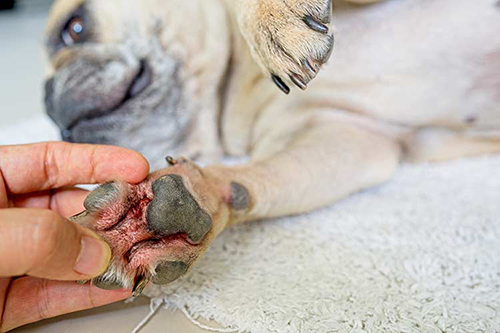
This picture demonstrates redness and inflammation in the interdigital spaces. This can point to an allergic reaction.
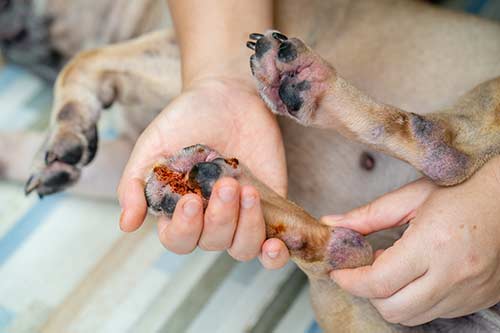
Dog paw allergies can also present with crusting and reddened skin due to yeast overgrowth.
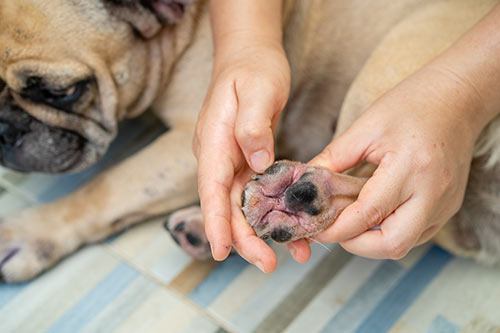
In this picture, note how the skin is thickened and rough due to prolonged inflammation/irritation.
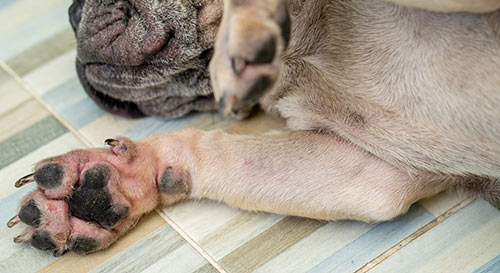
This dog paw shows inflammation, redness, and swelling of skin between the digits.
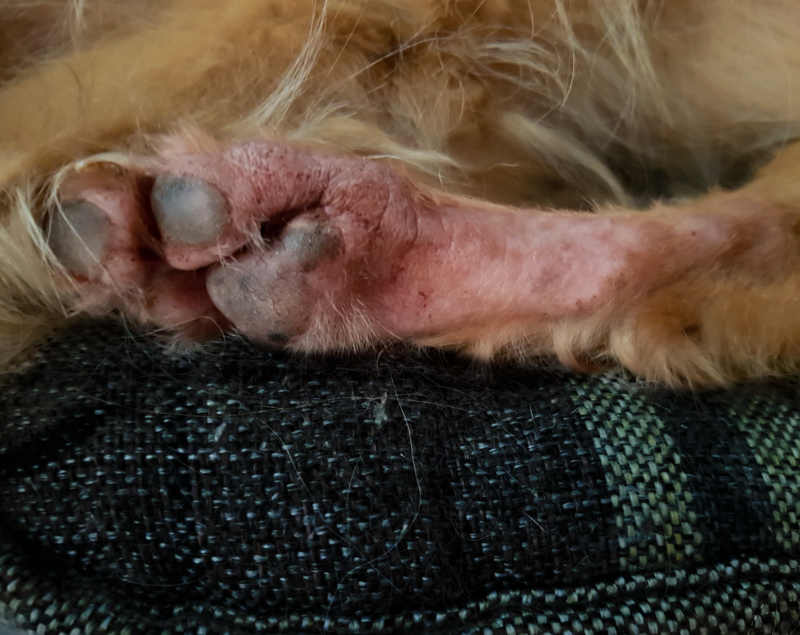
Common causes of dog paw allergies
Several allergens can cause itching and irritation and itching in dog paws.
Flea allergy dermatitis
Not only can fleas cause generalized itching in your dog, but their saliva acts as an allergen for many canines. When the pesky parasites bite a sensitive dog, they can cause intense itching and irritation of the skin. Most commonly, the dog’s hind end, including the back and tail are affected, but the rash and itching can spread to the paws.
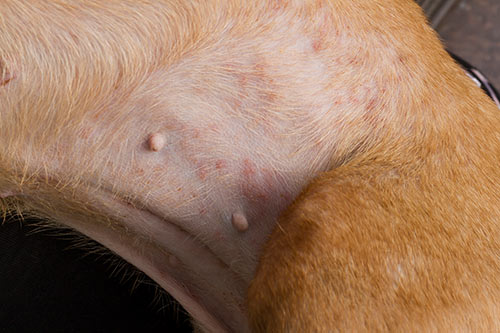
Flea allergy dermatitis on dog abdomen. Notice the irritated skin and red blotches.
When dogs suffer from flea allergy dermatitis, you may notice:
- Extreme itching characterized by scratching, chewing, or licking.
- Hair loss along the tail and back
- Open scabs and skin crusting from chewing/scratching
- Abruptly rising from a resting position
- Secondary skin infections
If you suspect or notice fleas on your dog, treat him with a flea dip or shampoo and wash his bedding. Talk to your veterinarian about products to clean the environment. Once you eliminate fleas from your dog, the irritation and itching should clear up. If your pup’s reaction is severe, your veterinarian can prescribe antihistamines to reduce inflammation and irritation.
Atopic dermatitis
Atopic dermatitis occurs when dogs develop sensitivities to environmental allergens that can be inhaled like pollen and grass. Usually, the irritation affects the face, feet, ears, and abdomen, The location of affected skin depends in part on your dog’s breed. Canines suffering from atopic dermatitis may exhibit:
- Scratching or rubbing the skin
- Chewing or licking the paws
- Hair loss from self-trauma
- Head shaking
- Reddened or tough skin
- Secondary skin infections
- Greasy skin
- Yeasty smell
Atopic dermatitis is the second most common allergy affecting dogs. The condition rarely resolves, but it can be managed. Treatment varies depending on the symptoms and severity of the skin reaction but may include:
- Routine bathing with prescription antimicrobial dog shampoo
- Avoiding the allergen(if it can be identified) – this is easier said than done
- Allergen-specific immunotherapy
Contact dermatitis(pododermatitis)
Dogs can also develop inflamed, itchy skin when they contact certain allergens like grass, dust mites, or chemicals. The condition usually manifests on the paws, belly, and other areas that have minimal hair cover. Signs of pododermatitis include:
- Red, swollen paws
- Abscesses and pus on the paws
- Blisters
- Ulcerations on the paws
- Hair loss
- Hyperpigmentation of paws from saliva
- Pad thickening
- Excessive licking or chewing of paws
- Secondary infections
As with atopy, pododermatitis may not be curable. However, you may be able to minimize the symptoms with appropriate treatment. Your veterinarian may prescribe:
- Antihistamines
- Steroids
- Cyclosporine
- Fatty acids
- Allergy injections
- Foot soaks
- Antifungals and antibiotics
The prognosis for pododermatitis is favorable for most dogs with a few lifestyle changes and appropriate treatment.
Food allergies
Food allergies in dogs are usually linked to a protein in the diet. When canine immune systems identify a protein as a threat, it can trigger skin or digestive reactions. Dogs with a sensitivity or allergy to an ingredient in their food may have symptoms including:
- Itchy skin
- Itchy paws
- Itchy ears
- Vomiting or diarrhea
- Weight loss
- Lethargy
- Hyperactivity
Like other allergies, food allergies in dogs are rarely curable. However, you can work with your veterinarian to identify the offending ingredient and then feed a diet that doesn’t include that protein allergen.
Tips for managing dog paw allergies
The best way to help your pal deal with paw allergies is by taking measures to promote skin and foot health. Depending on the type and severity of allergies your dog has, you can try the following measures to minimize allergy symptoms:
1. Avoid known irritants as much as possible
This may be easier said than done in some instances. However, if you know your dog’s triggers and can keep your dog from contacting them, it will reduce reactions.
2. Clean your dog’s environment thoroughly
Vacuum and sweep floors regularly to remove hair, dander, and dust. You should also wash your pet’s bedding and may want to consider investing in a quality air filter for the home.
3. Wash your dog’s paws
When your dog comes inside after he’s outdoors, wash his paws to remove pollen and other seasonal contact allergens. You can clean your furbaby’s feet with a Dog Paw Cleaner from Comotech. This product is available in small, medium, and large sizes and allows you to gently scrub mud, dirt, and unseen allergens from your dog’s pads and skin. The interior chamber is lined with silicone fingers to massage away grime. You can also clean your dog’s paw with a damp cloth and gentle dog soap/shampoo.
4. Use booties
Use pet booties on your dog’s feet to protect them from contact allergens. DcOaGt Dog Boots have breathable fabric to help keep your furbaby’s paws comfortable, the anti-slip bottom provides traction indoors and out while it protects your pup’s toes from allergens.
Check your dog’s paw’s regularly for signs of inflammation or redness
5. Use coconut oil as a paw balm
Apply soothing Raw Paws unrefined coconut oil to irritated, itchy paws. The all-natural paw balm helps to reduce inflammation and promote healthy skin.
6. Identify and eliminate food allergens
You may be able to use an elimination diet to discover which proteins or ingredients trigger an allergic reaction in your pooch. Once you find the allergens, switch your dog’s food to avoid offending ingredients. There are several hypoallergenic diets that use novel proteins.
Symptoms of dog paw allergies
Dogs can’t tell you they have allergies, so you have to be proactive. Observe your dog and check his feet regularly for visual signs of paw allergies so that you catch them as soon as possible. Common symptoms include:
- Incessantly licking or chewing the paws(including the tops of the paws)
- Flaky, dry skin
- Red or inflamed skin
- Swelling
- Secondary skin infections
- Yeasty odor
- Reddish-brown stains from saliva
How are dog paw allergies diagnosed?
To diagnose the cause of your dog’s paw allergies, your veterinarian will start by asking you about your dog’s diet, environment, and when the symptoms began. Then, the doctor will examine your furbaby and run diagnostic tests, including:
- Examining the skin between the toes
- Skin biopsy to test for allergies
- Blood tests
- Intradermal tests to identify allergens
- Elimination trials if a food allergy is suspected
Understand that finding a specific diagnosis for your dog’s allergies can be challenging.
When should I seek veterinary assistance?
There are many things you can try at home to ease your furbaby’s discomfort from itchy, inflamed paws. Sometimes, you can manage seasonal or food allergies with lifestyle and diet changes. However, if the allergy symptoms persist for more than a few days, contact your vet. When it comes to your dog’s quality of life, seeking assistance earlier is better than later.
Sometimes, allergic reactions can be severe enough to require emergency care. Take your dog to the vet if he suddenly has symptoms of anaphylaxis including:
- Swollen face and ear flaps
- Hives
- Difficult breathing
- Swollen footpads
What are the treatment options and likely costs for dog paw allergies?
Treatment of dog paw allergies often involves a multi-modal approach and may include:
- Paw soaks or medicated shampoos to reduce inflammation and prevent secondary infections. The estimated cost for these products is $15-30.
- Oral anti-inflammatory medications including oral Apoquel or prednisone can average $85-170
- Oral antihistamines like Benadryl may cost as low as $10
- Flea treatments to eliminate the parasites usually cost around $140-170 for a six-month supply
- Immunotherapy such as Cytopoint injections can run $300-500 for six months
- Hypoallergenic prescription diets – cost varies widely based on your dog’s size and formula.
Frequently asked questions
How can I tell if my dog’s paw issues are a result of allergies?
Dogs may lick and chew their paws for several reasons besides allergies, and it can be challenging to discern between the different conditions. You may be able to remove your pooch from the suspected allergen and see if the symptoms clear up. If your pup has paw issues, you must take him to the veterinarian for an examination and testing to reach a diagnosis.
How often should I clean my dog’s paws?
If your dog suffers from environmental or contact allergies, you should clean his paws every time he comes inside from being outdoors. For dogs that don’t react to grass pollen or other allergens that they might contact on a walk, check the feet and clean them as needed to remove dirt buildup.
Can dog paw allergies be completely cured, or are they lifelong?
Dog paw allergies are rarely curable. In most cases, once your furbaby develops an allergic sensitivity, you will have to manage it for the rest of his life.
Disclaimer: This website's content is not a substitute for veterinary care. Always consult with your veterinarian for healthcare decisions. Read More.


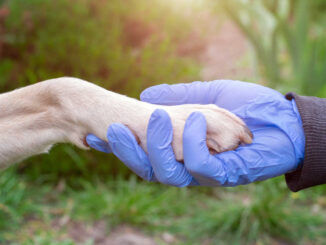
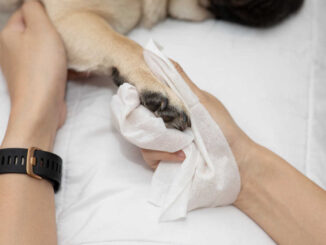

Our dog is allergic to Beef/Chicken.caused her to lick feet constantly.Anything I can do at home to relieve her paws?
Hey there and thanks for this question. I’m sorry to hear this. We firstly want to ensure these ingredients are not in any part of her diet (including treats, dental sticks, supplements etc.) As many dogs allergic to these ingredients will have other food allergies, I’d be considering a hydrolysed diet trial.
To stop licking, you can use a buster collar in the short term.
I would also bathe her paws twice daily in a dilute Chlorhexidine (Hibiscrub) wash. You can get this from any pharmacy and it is inexpensive. You dilute it 1:10 in water and apply with cotton wool or use a foot bath. Leave it on for 5-10 minutes, then rinse with water and pat dry.
If you do not have Hibiscrub, salt water can be used.
For chronic paw itching, a vet visit is best, so they can issue some anti itch medicine like Prednisone or Apoquel. This way, the ‘itch scratch cycle’ can stop, and things can settle.
Some dogs may also need antibiotics, if they have managed to introduce a secondary infection.
“The information on this website is not a substitute for in-person veterinary care. Always seek advice from your veterinarian if you have concerns about your pet’s medical condition.”
My dog, Macy, is allergic to grass. She already has monthly apoquel injections. We tried those immunotherapy drops for 2 years, but they didn’t seem to help. We have tried every wash imaginable. Macy LOVES to be outside, but I can’t imagine keeping booties on her all day every day is the answer. I was thinking about cotton baby socks, that we could put on a fresh set every time she goes outside, and remove them when she comes back in. Sure, we would go through 20 sets a day, but they are washable, breathable, and reusable. Your thoughts? We are desperate!!!
Hi there, and I’m so sorry to hear about this ongoing issue you’ve been having. With regards immunotherapy, I’m unfamiliar with drops, but highly recommend injectable immunotherapy, which should be done after an IgE blood test. I find we get really good results. If Apoquel is not keeping things in check, consider a different medication, such as Cytopoint injections.
For many dogs, they’ll have ongoing redness and itch due to secondary infections, so it is worth checking for fungal or bacterial overgrowth, as she may need a course of medicine to settle this.
In my experience neither socks nor booties work especially well, as they do not allow the feet to breathe and cause sweating, humidity and yeast overgrowth. As an alternative, I’d stick to non grassy routes i.e. trail paths, pavement, the beach etc.
It also helps to wash paws after each excursion, or to use doggy wet wipes on them.
“The information on this website is not a substitute for in-person veterinary care. Always seek advice from your veterinarian if you have concerns about your pet’s medical condition.”